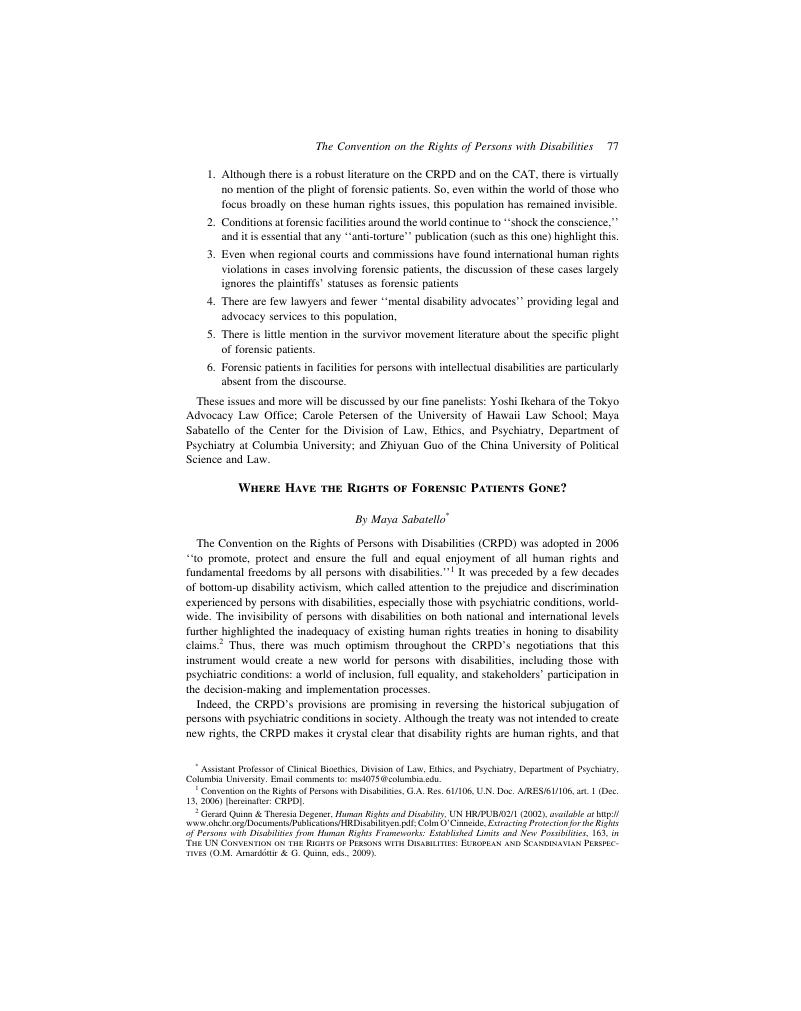Published online by Cambridge University Press: 20 January 2017

1 Convention on the Rights of Persons with Disabilities, G.A. Res. 61/106, U.N. Doc. A/RES/61/106, art. 1 (Dec. 13, 2006) [hereinafter: CRPD].
2 Gerard Quinn & Theresia Degener, Human Rights and Disability, UN HR/PUB/02/1 (2002), available at http://www.ohchr.org/Documents/Publications/HRDisabilityen.pdf; O’Cinneide, Colm, Extracting Protection for the Rights of Persons with Disabilities from Human Rights Frameworks: Established Limits and New Possibilities, 163, in The UN Convention on the Rights of Persons with Disabilities: European and Scandinavian Perspectives (Arnardoóttir, O.M. & Quinn, G., eds., 2009)CrossRefGoogle Scholar.
3 See, e.g., “Accessibility” and “Reasonable Accommodation” (Articles 9 and 2 of the CRPD, respectively).
4 CPRD, supra note 1, art. 1.
5 See, e.g., CPRD, supra note 1, arts. 3, 4, 8.
6 The following discussion is based on the CRPD’s negotiations archive, Ad Hoc Committee on a Comprehensive and Integral International Convention on the Protection and Promotion of the Rights and Dignity of Persons with Disabilities, available at http://www.un.org/disabilities/default.asp?id=1423
7 International Covenant on Civil and Political Rights, G.A. Res. 2200A (XXI), 52, U.N. Doc. A/6316, art. 9 (1966).
8 Working Group, Daily Summary Related to Draft Article 10 — Liberty and Security of the Person (Jan. 14, 2004), available at http://www.un.org/esa/socdev/enable/rights/wgsuma10.htm.
9 NHRI Response to the Questions Proposed by the Chair on Monitoring, seventh session of the Ad-Hoc Committee (Jan. 31, 2006), available at http://www.un.org/esa/socdev/enable/rights/ahc7nhri.htm.
10 This understanding was expressed by a few states representatives and the Chair of the Ad Hoc Committee, and may also be understood from the statement of the WNUSP above.
11 Hickey, Huhana, Indigenous People with Disabilities – The Missing Link, 229, in Human Rights and Disability Advocacy (Sabatello, M. & Schulze, M. eds., 2014)Google Scholar.
12 Sabatello, Maya, Disability, Human Rights and Global Health, 244, in 16 Law and Global Health: Current Legal Issues (Freeman, M. et al. eds., 2014)CrossRefGoogle Scholar.
13 See, e.g., Wetstein-Kroft, Susan & Vargo, James, Children’s Attitudes Towards Disability: A Review and Analysis of the Literature, 7 Int’l J. Advancement Counselling 181 (1984)CrossRefGoogle Scholar; Parens, Erik & Asch, Adrienne, The Disability Rights Critique of Prenatal Genetic Testing, 29 Hastings Ctr. Rep. (Special Supplement) S1–S22 (1999)Google ScholarPubMed.
14 Committee on the Rights of Persons with Disabilities, General Comment 1 – Article 12: Equal Recognition Before the Law, CRPD/C/GC/1 (Apr. 11 2014), available at http://tbinternet.ohchr.org/_layouts/treatybodyexternal/Download.aspx?symbolno=CRPD/C/GC/1&Lang=en.